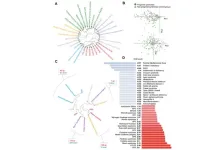(Press-News.org) The researchers found that 670 nanometres (nm) of red light stimulated energy production within mitochondria, the tiny powerhouses within cells, leading to increased consumption of glucose. In particular, it led to a 27.7% reduction in blood glucose levels following glucose intake, and it reduced maximum glucose spiking by 7.5%.
While the study was conducted in healthy individuals, the non-invasive, non-pharmacological technique has the potential to have an impact on diabetes control after meals, as it can reduce damaging fluctuations of blood glucose in the body that contribute to ageing.
The study also highlights the significant long-term consequences for human health, including the potential dysregulation of blood sugars posed by lengthy exposure to blue light. Given the prominence of LED lighting and the fact that LEDs emit towards the blue end of the spectrum with very little red, the authors suggest that this may be a potential public health issue. The research has been published in the Journal of Biophotonics.
Mitochondria provide energy for vital cellular processes, using oxygen and glucose to produce the energy-rich nucleoside adenosine triphosphate (ATP). Previous research has established that long-wavelength light between approximately 650-900 nm (spanning the visible through to the near-infrared range) can increase mitochondrial production of ATP which reduces blood glucose and also improves health/lifespan in animals.
The authors Dr Michael Powner, Senior Lecturer in Neurobiology in the School of Health & Psychological Sciences at City, and Professor Glen Jeffery, Professor of Neuroscience in the UCL Institute of Ophthalmology, also say that this improvement in ATP production can cause signalling changes that are transmitted throughout the body.
They suggest that it may be mediating the abscopal effect, which refers to the phenomenon in cancer treatment where specific irradiation of a primary tumour can result in shrinkage of secondary tumours located in a different part of the body. Likewise, 670 nm light shone selectively on to the backs of mice in previous studies has been shown to result in improvements in ATP that improve symptoms in both a model of Parkinson’s disease and a model of diabetic retinopathy.
To explore the impact of 670 nm red light on blood glucose, the researchers recruited 30 healthy participants, who were then randomised into two groups: 15 in the 670 nm red light group, and 15 in the placebo (no light) group. They had no known metabolic conditions and were not taking medication.
Participants were then asked to do an oral glucose tolerance test and record their blood glucose levels every 15 minutes over the next two hours. People who received red light exposure 45 minutes prior to drinking glucose exhibited a reduced peak blood glucose level and reduced total blood glucose during the two hours.
Dr Powner, who was the lead author of the study, said:
“It is clear that light affects the way mitochondria function and this impacts our bodies at a cellular and physiological level. Our study has shown that we can use a single, 15-minute exposure to red light to reduce blood sugar levels after eating.
“While this has only been done in healthy individuals in this paper, it has the potential to impact diabetes control going forward, as it could help to reduce potentially damaging glucose spikes in the body after meals.”
Professor Jeffery said:
“Sunlight has a balance between red and blue, but we now live in a world where blue light is dominant because although we do not see it, LED lights are dominant in blue and have almost no red in them. This reduces mitochondrial function and ATP production. Hence our internal environments are red-starved. Long-term exposure to blue light is potentially toxic without red. Blue light on its own impacts badly on physiology and can drive disrupted blood sugars that may in the long run contribute to diabetes and undermine health spans.
“Pre-1990, we all had incandescent lighting which was OK because it had the balance of blue and red similar to sunlight, but there is a potential health span time bomb in the change to LEDs in an ageing population. This can partly be corrected by spending more time in sunlight.”
The research was sponsored by Sight Research UK.
END
Red light can reduce blood glucose levels, says study
2024-02-21
ELSE PRESS RELEASES FROM THIS DATE:
UT-Battelle donates $186,000 to support SEEED’s green construction program
2024-02-21
Oak Ridge National Laboratory’s managing contractor, UT-Battelle, presented a donation of $186,000 to Socially Equal Energy Efficient Development, or SEEED, to support the nonprofit’s third green solar home as part of their Green Construction Program.
“We are committed to serving the communities that we live in,” UT-Battelle CEO and ORNL Director Stephen Streiffer said. “Our partnership with SEEED has provided a tremendous opportunity to share our scientific expertise, and we are excited that our support will help make this green solar home become a reality.”
Streiffer joined SEEED for a groundbreaking ceremony in Knoxville, Tenn., at the home project ...
Spinning, magnetic micro-robots help researchers probe immune cell recognition
2024-02-21
Researchers at the Pritzker School of Molecular Engineering and the Department of Chemistry at the University of Chicago have engineered tiny, spinning micro-robots that bind to immune cells to probe their function. The robot, or “hexapod,” gives scientists a new, highly adaptable way to study immune cells and to aid in the design of immunotherapies against cancer, infection, or autoimmune diseases.
Each hexapod robot has six arms containing molecules that might be recognized as foreign by the immune system — such as protein fragments from a tumor, virus, or ...
Helping patients with low income overcome eating disorders
2024-02-21
Individuals with eating disorders who have low income are frequently misdiagnosed and lack adequate access to appropriate therapy, according to researchers from Weill Cornell Medicine and Columbia University Vagelos College of Physicians and Surgeons.
Their paper, published in The Cognitive Behaviour Therapist on Feb. 19, identified the barriers to care that come with having low income and offered guidelines on how therapists can make accommodations for these patients to improve diagnoses and access to treatment.
Approximately 30 million people in the United States experience ...
Preventing relapse by restoring an opioid-weakened brain pathway governing behavior
2024-02-21
Medical University of South Carolina scientists report in Neuron that they have uncovered a way to restore an opioid-weakened brain pathway in a preclinical model.
With funding from the National Institute on Drug Abuse, part of the National Institutes of Health, the MUSC research team, led by neuroscientist James Otis, Ph.D., used advanced neuroscience tools to return a pathway between the thalamus and basal ganglia to healthy functioning in mice. As a result, this restoration prevented mice that were opioid-dependent from seeking or self-administering heroin. Results also suggested that sustained opioid use was the cause of this weakened pathway, rather than being caused by ...
Water quality monitor, locust-inspired electronic nose under development
2024-02-21
By Beth Miller
Two teams of engineers led by faculty in the McKelvey School of Engineering at Washington University in St. Louis will work toward developing products to monitor drinking water quality and to detect explosives with an electronic nose with one-year, $650,000 Convergence Accelerator Phase 1 grants from the National Science Foundation (NSF).
Barani Raman, professor of biomedical engineering, and Daniel Giammar, the Walter E. Browne Professor of Environmental Engineering, will lead teams of researchers from Washington University and other institutions and entities funded under the NSF’s Convergence Accelerator program, designed to address national-scale ...
Child tax credits provided significant relief to families experiencing economic shocks during COVID
2024-02-21
Contact:
Jillian McKoy, jpmckoy@bu.edu
Michael Saunders, msaunder@bu.edu
##
As a proposal to reinstate expanded Child Tax Credits (CTC) in the United States awaits a vote in the Senate, a new study led by Boston University School of Public Health (BUSPH) researchers reveals that the now-expired 2021 CTC expansion benefitted families experiencing financial setbacks due to health or employment challenges spurred by the COVID-19 pandemic.
Published in the journal Health Affairs Scholar, the study found that monthly advance payments included in the 2021 CTC ...
Plasma scientists develop computer programs that could reduce the cost of microchips and stimulate American manufacturing
2024-02-21
Fashioned from the same element found in sand and covered by intricate patterns, microchips power smartphones, augment appliances and aid the operation of cars and airplanes. Now, scientists at the U.S. Department of Energy’s (DOE) Princeton Plasma Physics Laboratory (PPPL) are developing computer simulation codes that will outperform current simulation techniques and aid the production of microchips using plasma, the electrically charged state of matter also used in fusion research. These codes could help increase the efficiency of the manufacturing process and potentially stimulate ...
Novel combination therapy offers promising results for treatment-refractory hepatoblastoma
2024-02-21
Hepatoblastoma (HB) is the most common liver cancer in children. Researchers and physicians in the field are concerned because in the last decade HB has been rising rapidly worldwide and has seen the most rapid increase among all pediatric solid tumors.
A team led by researchers at Baylor College of Medicine has been working on improving therapies for this devastating disease. They recently reported in the Journal of Hepatology a novel treatment strategy that produced encouraging results in animal models.
“High-risk disease leads to high rates of relapse and mortality,” said first author Dr. Andrés F. Espinoza, general ...
New study: Defining the progeria phenome
2024-02-21
“In sum, we have defined what a premature aging disease is and developed tools to allow diagnostics of patients and disease population.”
BUFFALO, NY- February 20, 2024 – A new research paper was published in Aging (listed by MEDLINE/PubMed as "Aging (Albany NY)" and "Aging-US" by Web of Science) Volume 16, Issue 3, entitled, “Defining the progeria phenome.”
Progeroid disorders are a heterogenous group of rare and complex hereditary syndromes presenting with pleiotropic phenotypes associated with normal aging. Due to the ...
Low oxygen in lakes may breathe new life into conservation efforts for water quality
2024-02-21
Abigail Lewis traveled all across the United States for college and graduate school, and she ended up researching lakes in her own hometown.
For one of her graduate research projects, Lewis analyzed 656 lakes across five continents with an international research team. The lakes in her hometown of Waukesha, Wisconsin, were among those included.
“To look back and pull together these two parts of my life has been really satisfying,” said Lewis, who will earn her Ph.D. in biological sciences this spring.
In a paper recently published in Global Change Biology, ...



